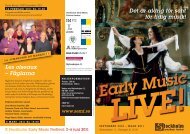festivalprogram - Stockholm Early Music Festival
festivalprogram - Stockholm Early Music Festival
festivalprogram - Stockholm Early Music Festival
You also want an ePaper? Increase the reach of your titles
YUMPU automatically turns print PDFs into web optimized ePapers that Google loves.
Torsdag 7 juni<br />
thursday 7. june<br />
S E M I N A R I U M • S E M I N A R<br />
kungliga mYntkaBinettet, toRsdag 7 juni 14.00<br />
the Royal coin caBinet, thuRsday 7. june 2.00 pm<br />
gFrån hästtransport till internet<br />
gThe DübenCollection<br />
prof. erik kjellberg, på svenska • in swedish<br />
dübens samling och musikhistoriens<br />
konstruktion<br />
I musikhistoriska sammanhang har<br />
man tidigare använt beteckningen<br />
”mellanbarocken” om senare hälften<br />
av 1600-talet – en övergångsperiod<br />
mellan den nydanande tidiga barocken<br />
(Monteverdi m.fl.) och den<br />
mogna senbarocken (Bach, Händel<br />
m.fl.). Men det finns flera skäl till att<br />
ägna en smula tid och eftertanke åt<br />
musiker som Kaspar Förster, Samuel<br />
Capricornus, Christian Geist, Vincenzo<br />
Albrici, Giuseppe Peranda,<br />
Johann Heinrich Schmelzer, David<br />
Pohle, Balthasar Erben. Denna generations<br />
komponister – och många andra – återfinns i Dübensamlingen<br />
(Uppsala universitetsbibliotek) vid sidan av mer kända<br />
namn som Heinrich Schütz och Dieterich Buxtehude. Man kan<br />
konstruera musikhistorien genom att ägna mästarmusikerna all<br />
uppmärksamhet och gå förbi de mindre kända namnen. Annorlunda<br />
blir situationen om vi intresserar oss för uppbyggnaden<br />
och mottagandet (receptionen) av musikkulturen som helhet.<br />
Idealiskt sett bör inkännande musikframföranden gå hand i<br />
hand med vetenskapliga och kritiska granskningar och reflektioner<br />
– och så sker glädjande nog på många håll idag.<br />
Hur musiken mottogs och uppfattades i sin egen tid – och<br />
uppfattas i vår egen – är en viktig fråga. Musiksamlingar har<br />
också sin egen historia som kan vara väl värd att undersöka.<br />
erik kjellberg, foto: petra werner kjellberg<br />
Erik Kjellberg<br />
The düben Collection and the construction of music history<br />
The traditional view of the later half of the 17th century has been<br />
labelled “the middle Baroque” – implying its intermediate stage between<br />
the path-breaking early Baroque (Monteverdi et. al.) and the<br />
consummate late Baroque (Bach, Händel et. al.). But there may be<br />
a number of reasons to devote time and interest in the company with<br />
musicians like Kaspar Förster, Samuel Capricornus, Christian Geist,<br />
Vincenzo Albrici, Giuseppe Peranda, Johann Heinrich Schmelzer,<br />
David Pohle, Balthazar Erben. <strong>Music</strong> of this generation of composers<br />
– and many others – is represented in the Düben Collection (Uppsala<br />
University Library) besides the more famous Heinrich Schütz and<br />
Torsdag 7 juni • Thursday 7. June<br />
Dieterich Buxtehude. As long as we construct our music<br />
history by following the paths of the master musicians, we<br />
could argue for an exclusion of the lesser renowned profiles. However,<br />
if we are interested in the reception of music culture in large – we<br />
might look at things a little differently. We should look into the musical<br />
sources with our eyes and ears wide open, otherwise we might<br />
loose facets and aspects of bygone days that should merit our attention.<br />
Sensitive performances should ideally go hand-in-hand with scholarly<br />
investigations and well-based information – fortunately this is quite<br />
often the case today.<br />
The ways music was transmitted and apprehended in its own time<br />
– and in our own – is an important issue. And music collections have<br />
their own story well worth to be dwelled upon.<br />
Erik Kjellberg<br />
C<br />
6 7<br />
b a<br />
L E S I d é E S H E U R E U S E S ( C A )<br />
Finska kYRkan, toRsdag 7 juni 18.00<br />
the finnish chuRch, thuRsday 7. june 6.00 pm<br />
g”Snillen komponerar”<br />
– Graupner vs Bach<br />
gThe Genius of Composition<br />
- Graupner versus Bach<br />
”rencontre en trio”<br />
seminariet presenteras av:<br />
Radioinspelning • Radio recording<br />
Spelas in av Sveriges Radio P2 och sänds 1 augusti kl. 19.30<br />
Recorded by Swedish National Radio, and broadcast 1. August 7.30 pm<br />
chRistoPh gRauPneR (1683-1760)<br />
Trio a 2 Violini e Cembalo i c-moll • in c minor (GWV 203)<br />
c 1744 autographe, d ds mus. ms. 472/2,2<br />
Vivace – largo – allegro<br />
chRistoPh gRauPneR<br />
Courante<br />
ur partita ”Vintern” i f-moll • from the partita ”the winter” in f minor,<br />
(gWV 121) 1733. cembalo solo • harpsichord solo<br />
johann seBastian Bach (1685-1750)<br />
Sonata II i A-dur • in A major<br />
för obligat cembalo och violin • for obbligato harpsichord and violin<br />
(BWV 1015) c 1720<br />
dolce [canon] – allegro assai –<br />
andante un poco [canon all’unisono] – Presto<br />
johann seBastian Bach<br />
Allegro<br />
ur sonata Vi i e-dur • from sonata vi in e major (BWV 1019), c 1740<br />
cembalo • harpsichord solo<br />
chRistoPh gRauPneR<br />
Sonata VI a tre i A-dur • Trio Sonata in A major (GWV 717)<br />
c 1738; autographe, d ds mus. ms. 472/1,6<br />
Without tempo indication (tempo giusto) – adagio –<br />
allegro – Presto – adagio – Presto



